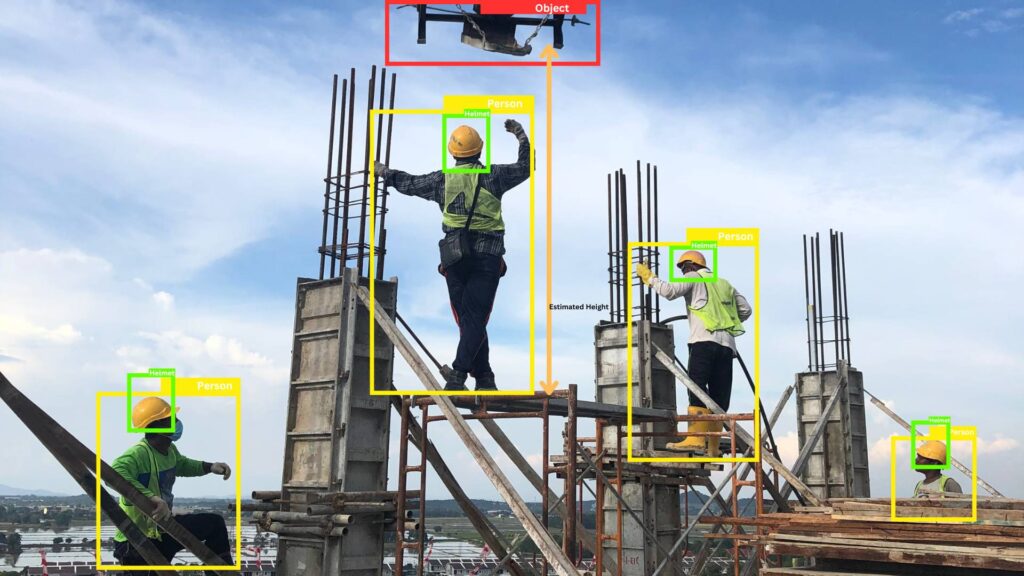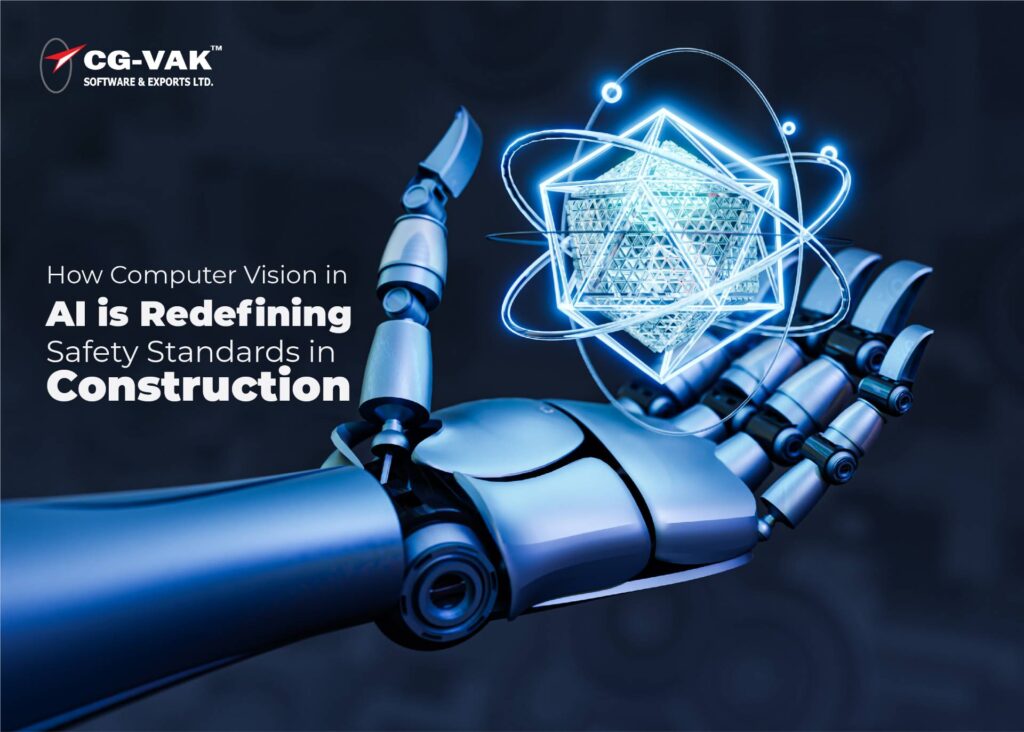The construction industry, a vital contributor to the global economy, representing 13% of the world’s GDP, has been grappling with a stagnant productivity growth rate and safety concerns. Despite its economic prominence, it grapples with a meager productivity growth rate of 1%, trailing behind the global industry average of 2.8% over the past two decades. Moreover, it stands as the most perilous industry in the United States and Middle East, witnessing more workplace fatalities than any other sector.
Addressing these pressing issues of low productivity and compromised worker safety is paramount for the construction industry’s sustained success and progress. Fortunately, recent advancements in artificial intelligence, particularly in the field of computer vision, offer promising solutions. The remarkable potential of computer vision lies in its ability to seamlessly integrate into existing construction workflows, enabling companies to adopt these cutting-edge technologies with relative ease.
By leveraging computer vision, construction firms can unlock substantial improvements in operational efficiency and enhance on-site safety measures, ultimately driving productivity gains while safeguarding the well-being of their workforce.
The construction industry’s path to revitalization hinges on its willingness to embrace innovative solutions, with computer vision emerging as a game-changer. By harnessing the power of this transformative technology, the sector can overcome longstanding productivity challenges and prioritize worker safety, paving the way for a more prosperous and sustainable future.
What is Computer Vision?
Computer vision is a field of artificial intelligence that enables machines to perceive and understand digital images and videos in a way that mimics human vision. It empowers computers to interpret and make sense of the visual world around them, much like how our brains process and comprehend the images our eyes capture.
In layman’s terms, computer vision is the science of teaching computers how to “see” and interpret visual information. It involves developing computer vision system algorithms and models that can automatically analyze and extract meaningful insights from digital images, videos, and other visual data.
At its core, computer vision works by converting digital images or video frames into numerical data that can be processed and analyzed by computers. This process typically involves several steps:
Image Acquisition
The computer captures or receives digital images or video frames from cameras or other visual sensors.Pre-processing
The visual data is prepared for analysis by applying techniques such as noise reduction, color correction, and image enhancement.Feature Extraction
Distinctive features, such as edges, shapes, textures, and patterns, are identified and extracted from the visual data using specialized algorithms.Object Recognition and Classification
The extracted features are compared against pre-trained models or databases to recognize and classify objects, people, or activities within the visual data.Interpretation and Analysis
The recognized objects, patterns, and relationships are interpreted and analyzed to extract meaningful insights, such as identifying potential safety hazards, monitoring construction progress, or detecting defects or anomalies.
In the construction industry, computer vision can play a crucial role in enhancing site operations and worker safety. For example, it can process visual data from surveillance cameras or drones to monitor site activities, detect potential hazards (e.g., workers operating in dangerous areas or not wearing proper safety equipment), and track the progress of construction projects in real-time.
Furthermore, computer vision can be integrated with advanced technologies like augmented reality (AR) or mixed reality (MR) systems, allowing construction professionals to overlay digital information and instructions directly onto their visual field, enhancing situational awareness and enabling more efficient and safer operations.
By leveraging the power of computer vision, the construction industry can unlock new levels of operational efficiency, productivity, and worker safety, ultimately driving innovation and sustainable growth within this vital economic sector.
How does Computer Vision contribute to the construction industry?

Computer vision, an AI-driven technology, plays a pivotal role in revolutionizing the construction industry by enabling automation, enhancing safety measures, boosting productivity, and improving quality control across various aspects of construction management. This cutting-edge AI and machine learning (ML) service has the potential to transform the way construction projects are executed, monitored, and managed.
Safety Management:
One of the most significant contributions of AI-driven computer vision technology is its ability to aid in safety monitoring on construction sites. By leveraging advanced image and video analysis techniques powered by AI and ML, these systems can detect potential hazards, ensure compliance with safety protocols, and prevent accidents through real-time monitoring. This proactive approach to safety management not only protects workers but also helps mitigate risks, reduce downtime, and minimize costly accidents, making AI in the construction industry a game-changer.Progress Monitoring:
Computer vision technology, facilitated by cloud computing and AI/ML services, offers a powerful solution for real-time progress tracking in construction projects. Project managers can leverage this technology to monitor construction activities, identify delays or bottlenecks, and optimize project timelines efficiently. By providing accurate and up-to-date information on project progress, AI-driven computer vision enables data-driven decision-making and facilitates proactive measures to keep projects on schedule.Productivity Tracking:
Automating monitoring processes is a game-changer for productivity tracking in the construction industry. AI-powered computer vision systems can analyze visual data to measure productivity metrics, identify inefficiencies, and optimize resource allocation. This data-driven approach not only enhances project efficiency but also provides valuable insights for continuous improvement and streamlining of construction processes.Quality Control:
Ensuring adherence to construction standards and maintaining high-quality workmanship is crucial in the construction industry. AI-driven computer vision technology assists in quality control by detecting defects, assessing workmanship, and ensuring compliance with construction standards. This automated quality assurance process helps identify and address issues early, reducing rework and minimizing costly repairs or replacements.Data Analysis and Insights:
The vast amount of visual data collected from construction sites through cameras, drones, and other imaging devices can be leveraged by AI-powered computer vision systems to provide valuable insights. By analyzing images and videos, these cloud-based AI/ML services can generate comprehensive data reports, enabling data-driven decision-making, risk assessment, and performance evaluation in construction projects.
The integration of AI-driven computer vision technology into the construction industry has the potential to revolutionize construction management practices, enhancing safety, productivity, quality, and overall project efficiency. As this AI and ML service continues to evolve and become more sophisticated, its impact on the construction industry is expected to grow, paving the way for more innovative and sustainable construction practices leveraging the power of cloud computing and AI/ML technologies.
Implementing Computer Vision in Your Construction Business
Implementing computer vision technology in your construction business is a strategic decision that can yield significant benefits, revolutionizing various aspects of your operations. However, the integration process demands careful planning, execution, and collaboration with experienced technology partners. Here’s a comprehensive guide to help you successfully adopt computer vision in your construction business:
Here are steps to Integration:
Define Your Goals:
Clearly identify the areas where you aim to leverage computer vision technology, such as safety monitoring, progress tracking, productivity analysis, or quality assurance. Prioritize your goals based on your business needs and pain points.Assess Your Infrastructure:
Evaluate your existing infrastructure, including cameras, sensors, computing resources, and data management systems. Determine if upgrades or expansions are necessary to support the seamless integration of computer vision solutions.Select the Right Solution:
Conduct thorough research and evaluate different computer vision solutions tailored to the construction industry. Consider factors like scalability, accuracy, reliability, integration capabilities, user-friendliness, and customization options.Pilot Testing:
Implement a pilot program to assess the performance and effectiveness of the chosen computer vision solution in a controlled environment. This will help identify potential issues, fine-tune the system, and ensure a smooth full-scale implementation.Data Integration:
Ensure the computer vision system can seamlessly integrate with your existing data management systems, such as project management software, enterprise resource planning (ERP) systems, or building information modeling (BIM) platforms, enabling efficient data exchange and streamlined workflows.Train Your Team:
Provide comprehensive training to your team members who will interact with or manage the computer vision system. Ensure they understand its capabilities, limitations, and best practices for optimal utilization and data interpretation.Roll-out and Continuous Improvement:
After successful pilot testing, gradually roll out the computer vision solution across your construction projects. Continuously monitor its performance, gather feedback from users, and implement improvements or upgrades as needed to maximize its effectiveness.
How to Choose the Right Solution
When selecting a computer vision solution, consider factors such as scalability, accuracy, reliability, integration capabilities, user-friendliness, and customization options. Look for solutions that align with your specific construction processes and requirements, enabling seamless integration and long-term scalability.
Focus on Partnership and Support
Implementing computer vision technology is a significant undertaking, and partnering with experienced technology providers can be invaluable. Look for vendors with expertise in the construction industry, offering professional services, comprehensive training, and ongoing support.
Seek vendors that provide installation, configuration, and customization services to ensure a smooth implementation tailored to your unique needs. Additionally, prioritize providers that offer reliable support, regular software updates, and consulting services, along with AI prompt assistance, to help your team effectively utilize the AI-driven computer vision solution and maximize its benefits over time.
Carefully evaluating and selecting the right AI-driven computer vision solution, and partnering with experienced technology providers, your construction business can successfully implement this cutting-edge technology. This strategic investment will unlock new levels of safety, productivity, quality control, and efficiency, driving innovation and sustainable growth in your construction operations.
Conclusion
Integrating computer vision technology into heavy equipment safety systems provides significant benefits for businesses and workers by enhancing worker safety and reducing accident risks. This advanced technology can detect blind spots, power collision avoidance systems, analyze operator behavior for fatigue or distraction, enable real-time monitoring and alerting of unsafe conditions, develop smart control systems, optimize site planning and design, and ensure proper personal protective equipment usage. By leveraging computer vision, businesses demonstrate their commitment to environmental, health, and safety standards, creating a safer work environment. EHS managers can utilize the data and insights gathered to inform safety training, improve protocols, reduce accidents and injuries, and improve overall EHS compliance. If interested in exploring how computer vision can benefit your heavy equipment safety systems, request a free demo to experience the potential of this cutting-edge technology.
